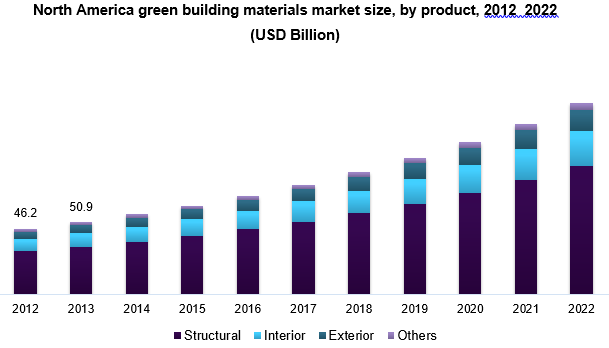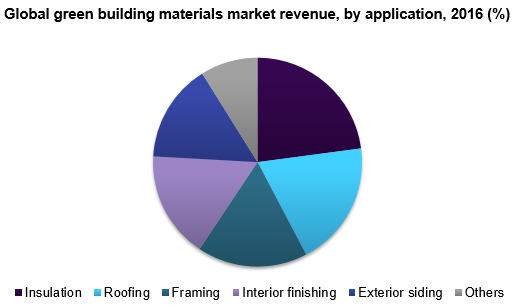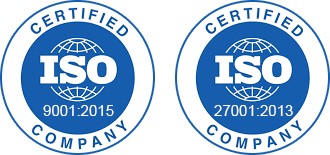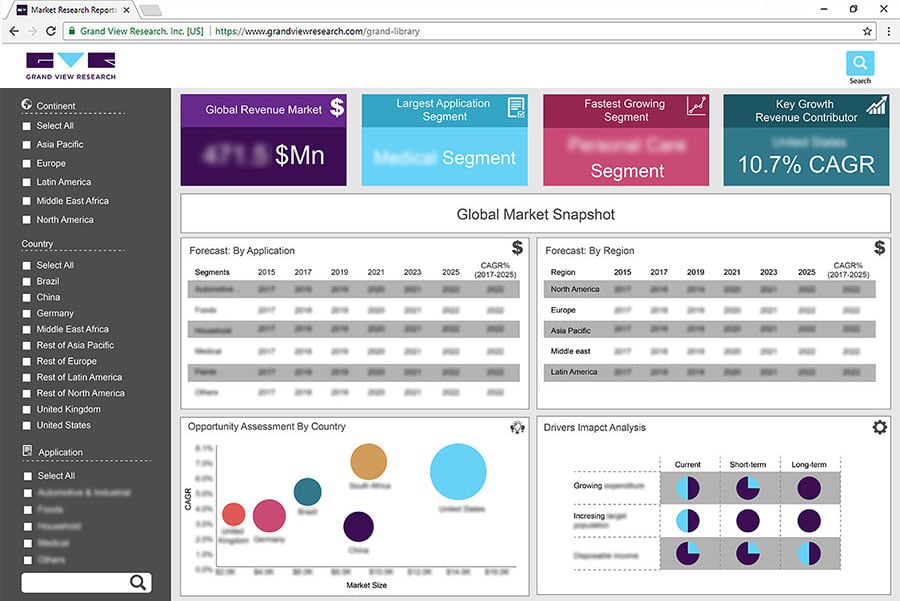- Home
- »
- Green Building Materials
- »
-
Global Green Building Materials Market Size, Industry Report, 2022GVR Report cover
![Green Building Materials Market Size, Share & Trend Report]()
Green Building Materials Market Size, Share & Trend Analysis Report By Product, By Application (Framing, Insulation, Roofing, Exterior Siding, Interior Finishing), And Segment Forecasts, 2012 - 2022
- Report ID: 978-1-68038-551-9
- Number of Report Pages: 100
- Format: PDF, Horizon Databook
- Historical Data: 2014-2016
- Forecast Period: 2018 - 2022
- Industry: Advanced Materials
Industry Insights
The global green building materials market size was estimated at USD 192.3 billion in 2016, growing at a CAGR of 11.2% over the forecast period. Expanding construction activities and increasing government initiatives for the implementation of environmental-friendly and energy-efficient building standards is expected to drive the market growth over the forecast period.
Green building materials offer lower carbon footprint, thereby reducing the impact of global warming. In addition, these are easy to maintain and consume less water as compared to its counterparts. As a result, growing product demand owing to various monetary and environmental benefits is expected to propel the industry growth over the forecast period.

Construction sector is expected exhibit high demand as the developers and consumers are putting a high emphasis on cost-saving, environmental-friendly, and energy-efficient structures. Industry growth is also aided by the recovery in construction activity as demand for residential and commercial projects rebounds.
Increasing government focus on energy-efficiency and green buildings as a stimulus against recent global crisis is expected to influence the product demand. Rising energy costs and high performance green building products are the primary industry propellants. However, uneven enforcement of energy regulation and highly price-sensitive consumers may hamper the growth of the industry.
The industry exhibits low bargaining power of suppliers owing to the easy availability of raw materials and a large number of suppliers present in the market. The manufacturers opt for direct supply of product to the consumers or application industries. However, expansion on global scale by major companies has led to the existence of third-party distributors.
Canada, China, India, Brazil, and South Korea are certified by U.S. Green Building Council (USGBC) for adopting green building codes. Adoption of these green building codes by U.S. and European Union is likely to influence other countries to adopt the same in order to reduce carbon emissions.
Product Insights
Structural products segment is expected to grow at a CAGR of 11.4% over the forecast period owing to its ability to reduce carbon emissions and provide superior durability at a lower cost. Construction industry growth particularly in developing economies is expected to have a positive impact on the industry growth.
Interior materials are estimated to be the second largest market on account of rising consumer awareness regarding the environmental benefits they offer such as superior aesthetics, enhanced lightning, and improved indoor air quality. In addition, these materials control humidity and allows better control over air quality, which is expected to augment its growth over the forecast period.
Application Insights
Insulation is estimated to be the largest application segment, which is expected to reach USD 85.9 billion by 2022, owing to its ability of energy conservation. Increasing construction activities in the residential and commercial sector are expected to aid the growth of this segment in the forecast period.

Roofing accounted as the second largest application, followed by framing. These products are manufactured using recycled materials including rubber, slag, sludge, stone granules and corrugated mixed paper. Growing popularity of non-toxic recycled rubber roofing owing to its weather-resistance and superior durability is expected to drive the product demand for roofing applications.
Regional Insights
North America is estimated to be the largest market, accounting for over 35% of the total market share. This trend is expected to continue in the foreseeable future owing to the building codes and favorable policies regarding use of green building materials in the construction industry, coupled with increasing renovation activities.
Asia Pacific is expected to witness the fastest growth of 12.0% over the forecast period, owing to the growing residential construction sector in the region. Paris climate agreement signed by India and China in order to prevent the climate change, coupled with increasing infrastructure development in both countries is expected to drive the product demand in the region.
Rise in implementation of green building regulations by various governments in Europe is expected to drive the industry growth in the region. In addition, increasing emphasize to reduce maintenance and operational costs of structure is predicted to aid the demand for green building materials in Europe over the forecast period.
Green Building Materials Market Share Insights
The market exhibits a growing activity of forward integration by raw material suppliers due to growing demand and infinite growth prospects of the market. Regional dominance of industry participants is expected to decrease owing to growing demand for imports. This trend is expected to continue over the next few years and is likely to propel the market growth.
Key industry participants include PPG Industries, E. I. du Pont de Nemours and Company, Forbo International SA, Interface Inc., Kingspan Group plc, Lafarge, BASF SE, Owens Corning, National Fiber, RedBuilt, LLC, CertainTeed Corporation, Binderholz GmbH, Bauder Limited and Alumasc Group.
Report Scope
Attribute
Details
Base year for estimation
2016
Actual estimates/Historical data
2012 - 2015
Forecast period
2017 - 2022
Market representation
Revenue in USD Billion and CAGR from 2017 to 2022
Regional scope
North America, Europe, Asia Pacific, Central & South America, Middle East & Africa
Report coverage
Revenue forecast, competitive landscape, growth factors and trends
15% free customization scope (equivalent to 5 analysts working days)
If you need specific market information, which is not currently within the scope of the report, we will provide it to you as a part of customization
Share this report with your colleague or friend.
![gvr icn]()
NEED A CUSTOM REPORT?
We can customize every report - free of charge - including purchasing stand-alone sections or country-level reports, as well as offer affordable discounts for start-ups & universities. Contact us now
![Certified Icon]()
We are GDPR and CCPA compliant! Your transaction & personal information is safe and secure. For more details, please read our privacy policy.
We are committed towards customer satisfaction, and quality service.
"The quality of research they have done for us has been excellent."





